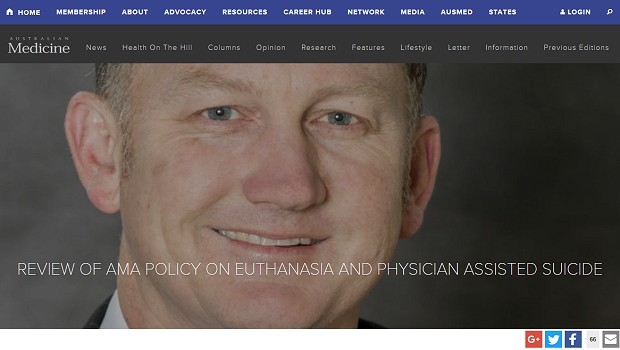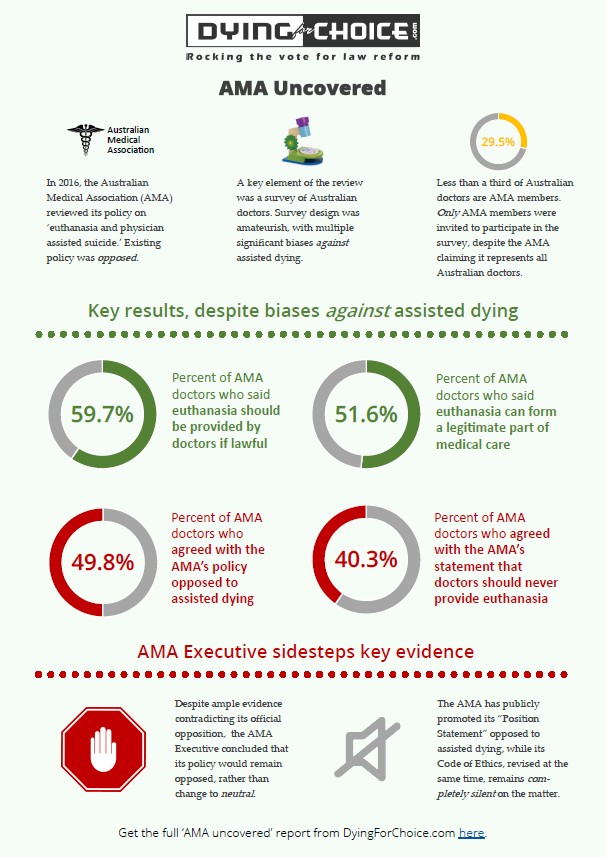AMA uncovered: dud assisted dying policy 'review'

In 2016, the Australian Medical Association (AMA) reviewed its policy on ‘euthanasia and physician assisted suicide.’ Despite ample evidence to the contrary, the AMA executive set its policy as opposed to assisted dying, when the only position that would have acknowledged and respected the views of most of its membership was a position of neutrality.
 Infographic summary of 'AMA uncovered'
Infographic summary of 'AMA uncovered'
Get the PDFs: Infographic | 'Sixteen questions' | Full report
AMA policy review
The Australian Medical Association (AMA) has been historically opposed to legislative reform that would permit doctor-assisted dying for patients in unremitting and untreatable extremis. Its hostile position had been expressed through a Position Statement (PS) in effect for at least a decade, although its Code of Ethics has been completely silent on the matter.
The AMA’s opposition to doctor-assisted dying has been one of the factors leading to the failure of a number of attempts at assisted dying law reform.
In 2015 the AMA announced a review of its ‘policy’ on ‘euthanasia and doctor assisted suicide,’ managed through its Federal Council. The review was conducted from late 2015 and throughout 2016. It included an online survey of more than 3,700 Australian doctors.
Deeply flawed survey — against assisted dying
The survey methodology contained, however unconsciously, multiple serious design flaws biased against assisted dying: flaws which were brought to the attention of the AMA executive separately by two survey design experts. The executive dismissed the criticisms, incoherently arguing that while the AMA’s reviews are “fully-informed decisions based on well-researched, comprehensive information,” the survey was “not formal ‘research’ as such” and merely a “means to engage our members.”
The AMA relied on selected statistics from the survey to publicly explain the outcome of its review. It also provided its own members a private, detailed report of the review, of which more than half was a comprehensive statistical analysis of the survey.
The ‘Survey Limitations’ section of the report mentioned several minor issues, but not the significant biases brought to the attention of the executive by experts.
Yet supportive doctor responses
Despite these significant biases against assisted dying, the survey found:
- 68% of doctors said that even with optimal care, complete relief of suffering is not always possible.
- 60% of doctors said that if lawful, euthanasia should be provided by doctors, and more than half of them (total 32%) said that they would indeed practice it.
- 52% of doctors said that euthanasia can form a legitimate part of medical care.
- 50% of doctors expressly disagreed with the AMA’s statement that “doctors should not provide euthanasia under any circumstances.”
- 38% of doctors expressly disagreed with the AMA’s policy opposed to assisted dying (only half expressly agreed), and 35% of doctors said that euthanasia should be lawful.
Some doctors oppose legalisation, not euthanasia itself
In relation to the last point, other scholarly research has found that an additional 25% of Australian doctors are opposed to law reform not because they are opposed to assisted dying itself, but because they would rather practice it in private without regulatory ‘interference.’ This confirms that more than half of Australian doctors believe assisted dying can be a legitimate and practical part of medical care.
AMA not representative of Australian doctors
Only AMA members were invited and permitted to participate in the survey, and more than 70% of Australian doctors are not AMA members, despite the AMA expressly advancing itself as representing all Australian doctors. Non-members are likely to be more supportive of assisted dying — snubbing AMA membership due to the AMA’s ‘officially’ hostile stance.
Hostile tweets by President during review
During the review process, AMA President Dr Michael Gannon made repeated public statements hostile towards assisted dying, including a statement that doctor assisted dying would offend the Declaration of Geneva. The Declaration has nothing specific to say about assisted dying, and any general Declaration statements Dr Gannon relied upon would be equal arguments against abortion. Yet the AMA accepts abortion practice by doctors.
Indefensible conclusion by AMA Executive
Finally, in the face of ample evidence (despite the methodological biases) that at least half of the AMA’s own members favour doctor involvement in lawful assisted dying and deem it legitimate medical care, and 38% of its own members expressly disagreeing with its opposed policy, the AMA executive decided to maintain ‘official’ organisational opposition in the revised PS.
The PS, which was previously named broadly as about ‘end of life care’, is now exclusively named as about ‘euthanasia and physician assisted suicide,’ even though it continues its broad coverage. This suggests that, however unconsciously, the executive’s attitudes against assisted dying have become more entrenched.
The PS continues to unequivocally state as before that “The AMA believes that doctors should not be involved in interventions that have as their primary intention the ending of a person’s life.” In announcing the conclusions of its review the AMA has promoted this statement widely and as though it applies to all Australian doctors, most of whom are not AMA members.
Neither AMA 'policy' nor its Code of Ethics is binding
Despite the confidence and certainty of the statement, the AMA advises that neither Australian doctors in general nor even its own members are bound by its PSs. Thus, statements in AMA PSs are more ‘suggestions’ or ‘thought bubbles’ rather than authoritative statements.
More recently, the AMA’s Code of Ethics has been updated, yet remains entirely silent on doctor-assisted dying, in curious contradiction of the ‘certainty’ of its PS. The Code of Ethics is not binding on doctors (even AMA members), either.
Incoherent demands for policy consultation
The AMA executive continues to demand deep involvement in the development of a legal framework for assisted dying (despite saying that doctors should not be involved in the practice), yet it has developed no specific frameworks for three other related, already-lawful medical practices: refusal of life-preserving medical treatment, continuous deep sedation until death, and the voluntary refusal of food and fluids.
These discrepancies collectively raise the question as to whether the AMA’s ‘official’ opposition to assisted dying law reform is political rather than medical.
Conclusison
The evidence is clear that the only “justifiable” position the AMA executive could have taken was to declare the AMA neutral towards lawful assisted dying — a matter of individual conscience for its member doctors.
Australian doctors may well question the AMA executive as to how such a flawed process arrived at the outcome it did, and a collection of questions are posed for the AMA to answer. Sixteen questions are posed below.
Get the PDFs: Infographic | 'Sixteen questions' | Full report
Sixteen questions for the AMA
- Why does the AMA, through its Tasmanian representative, think it appropriate to state on national television that dying patients in extremis and without relief can suicide by themselves, even if the AMA doesn’t “encourage” it?
- Why did the AMA repeatedly delete corrections to its negative MJA misinformation about assisted dying practice in Belgium?
- Why did the AMA decide to review its “policy on euthanasia and physician assisted suicide” when it didn’t specifically have one? It had a policy on the role of doctors in end of life care.
- Why did the AMA review comprehensively ignore the substantial secondary data that already exists about the attitudes and practices of doctors and patients in end of life decisions?
- Why did the AMA not proactively obtain professional advice and assistance with the design and conduct of its doctor survey, and prefer to use such an amateurish one?
- If the AMA really represents all Australian doctors, why did it expressly exclude more than two thirds of them from its survey?
- Why did the AMA persistently use inappropriate language and inadequate definitions about assisted dying?
- Why did the AMA not make any serious attempt to understand patient perspectives beyond superficial statements that ‘opinions are divided’?
- Why did the AMA not report the multiple significant biases in its survey, which it knew about, in the ‘limitations’ section of its final report?
- Why did the AMA President consider it appropriate to make multiple statements hostile towards assisted dying while the review was underway?
- Why did the AMA executive decide to continue to demand doctors not participate in assisted dying, when more than half of its own members said it could be appropriate clinical practice provided by doctors, nearly four in ten expressly disagreed with the policy, and a third said they’d participate if assisted dying were legalised?
- Why does the AMA consider it appropriate to make repeated categorical, public statements that doctors should not be involved in assisted dying, when its Position Statement is not binding on its own members, let alone all Australian doctors?[1]
- How can the AMA justify the incoherence of having an expressly opposed stance to assisted dying in its revised Position Statement while it remains totally silent on the matter in its Code of Ethics, revised at the same time?
- How can the AMA legitimately demand to be centrally involved in developing an assisted dying framework — in which it says doctors should not be involved — for law reform, when it has no frameworks at all for the similar contexts of refusal of life-preserving medical treatment, continuous deep sedation until death, and the voluntary refusal of food and fluids (all currently lawful and practiced)? When will it develop and publish those?
- Why does the AMA continue to present itself to the media and the public as representing all Australian doctors, when more than two thirds of them are not members?
- Will the AMA include a formal analysis and critique of this deeply flawed policy review as part of its modernisation efforts in order to rebuild its brand value and stem the falling tide of its membership? That is, is the AMA prepared to learn from its mistakes?
[1] The AMA’s Code of Ethics is not binding even on its own members, either. So when the Code states “don’t engage in sexual, exploitative or other inappropriate relationships with your patients,” that’s merely a ‘suggestion’ or ‘recommendation’ rather than an ‘obligation’ as a member of the AMA.

